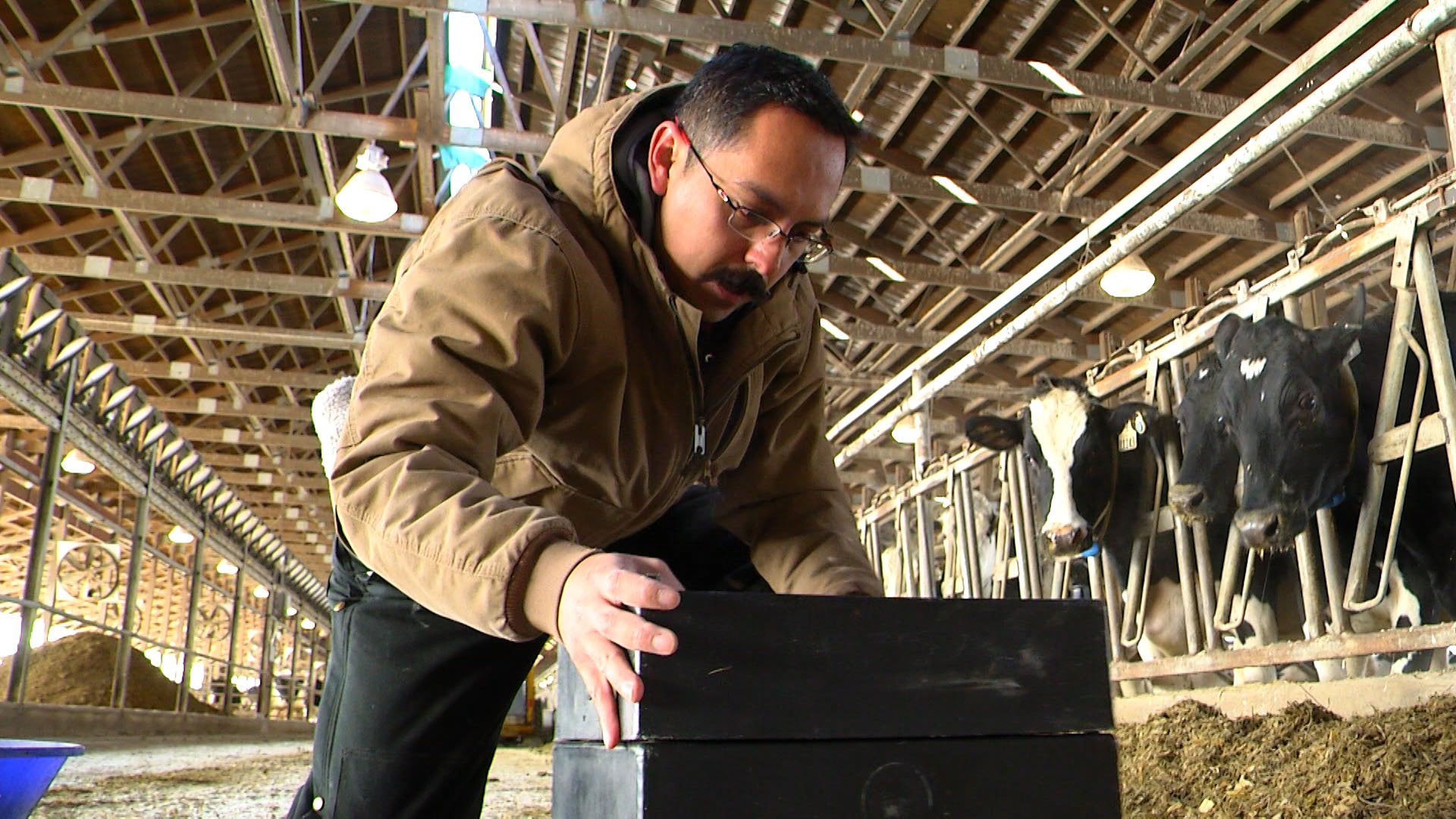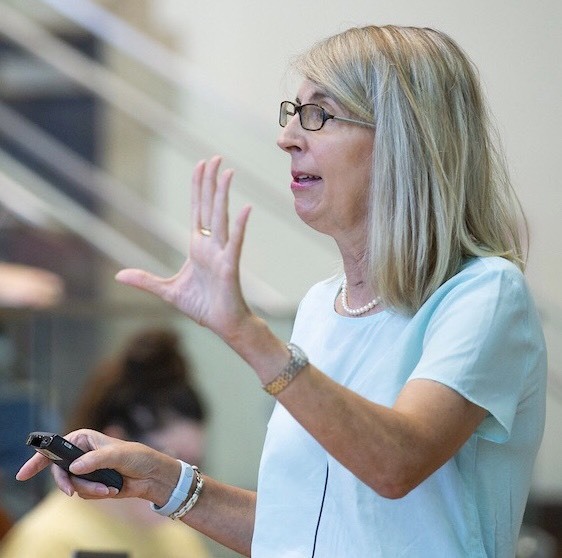This is the latest entry in a series of articles telling the personal stories of Iowa State University faculty and scientists whose work is changing the world for the better. Click here for the complete list of Change Agents.
AMES, Iowa – They’re like Fitbits, but for cows.
Wearable technologies that fit on your wrist and keep track of various health metrics have caught on among the human population, but researchers like Hugo Ramirez, an assistant professor of animal science at Iowa State, use similar devices to keep track of the health of cows at the ISU Dairy Farm. While many humans use wearable technology to compulsively monitor how many steps they take every day or how many hours they spend sleeping, Ramirez tracks the body temperature of dairy cows and how long they spend ruminating.
The data gathered by the devices informs Ramirez’s research in dairy nutrition, helping him to develop new approaches to diet that allow dairy producers to take better care of their animals and improve their bottom lines. Ramirez’s focus on agricultural education grew out of an upbringing in central Mexico, where his father was a faculty member at an ag-centric university.
The path to teaching, research and outreach
Ramirez grew up in the state of Guanajuato, in central Mexico. His father was a member of the forestry faculty at Chapingo University, and Ramirez said his academic upbringing inspired him and his sisters to pursue higher education and agriculture. One of his sisters studied agricultural economics, another studied plant physiology and Ramirez pursued animal science.
“Each of us had a different path,” Ramirez said. “But I think definitely the upbringing in that academic environment is what led me to have that interest in pursuing an advanced degree, always following what I liked, which were farm animals.”
As a college sophomore, Ramirez entered an exchange program that took him to the University of Nebraska – Lincoln. That experience introduced him to the land-grant mission of teaching, research and outreach. He earned his undergraduate animal science degree at the Universidad Autonoma Chapingo in Mexico, then pursued a master’s and Ph.D. in ruminant nutrition at Nebraska.
After a stint working in dairy production and then doing extension and teaching work at Tarleton State University in Stephenville, Texas, Ramirez joined the ISU faculty in late 2015. His current position requires him to conduct research with direct application for dairy producers, as well as teach a capstone dairy science course. Ramirez said the three distinct parts of his job – teaching, research and outreach – reinforce one another. For instance, his near daily contact with Iowa’s dairy producers guides what material he includes in his course curriculum.
“Students are going to be facing those situations very soon after they graduate so I like to bring as much experience as I can from the field into the classroom,” he said.

Hugo Ramirez sifts through feed to weigh its components in a barn on the ISU Dairy Farm. Larger image.
Wearable technology and dairy nutrition
Much of Ramirez’s research takes place at the ISU Dairy Farm, south of Ames. The farm is home to nearly 350 dairy cows that must be milked three times a day. On a recent frigid February morning, Ramirez, clad in heavy winter gear, sifted through feed in a barn to weigh its various components. Dozens of cows looked on, mooing occasionally, as he recorded the results.
Ramirez and his colleagues at the farm track a wide range of metrics related to the nutrition and performance of the cows. That’s where the wearable technology comes in. They equip the cows with ear tags that monitor the temperature of each cow. The tags and collars also monitor how much time each cow spends eating and ruminating. Some of the sensors are capable of monitoring jaw movement to accurately measure how much time a cow chews her cud, Ramirez said. The scientists also put pH sensors in pills that are fed to the animals to track the acidity inside their digestive tracts.
All this data paints a picture of each cow’s health and productivity. A sudden spike or drop in temperature gives an indication a cow may be ill 24-36 hours before clinical symptoms of the disease emerge, he said. And tracking time spent eating and ruminating helps the researchers understand how well the cows respond to the feed they’re given.
Ramirez said he’s testing the use of probiotics, or substances that work with the microorganisms present in a cow’s digestive system, to gauge the effects on health and milk production. He said protected methionine, an amino acid with a coating that prevents microbes in the cow’s rumen from breaking it down, has shown promise as a way of helping cows unlock the maximum nutritional benefits from their feed. Cows need amino acids to build proteins, but the rumen microbes can break them down before the cow’s digestive system can absorb them fully. The lipid coating of protected methionine gives the cow’s digestive system more time to derive those nutritional benefits, leading to milk with greater fat and protein content.
“So, by having this technology that allows cows to produce more protein overall, dairy farmers will be able to produce or deliver more pounds of protein to a processing plant and overall have a better economic outlook and better price for their product,” Ramirez said.
Food safety also ranks among Ramirez’s top concerns. He said all milk, whether produced on conventional, grass fed or organic operations, must undergo multiple checks for the presence of antibiotics. Any milk with even a trace of antibiotics is destroyed before it reaches the market, he said.
“Everyone in the dairy industry works to make sure we deliver a safe and wholesome product,” he said.
Contacts
Hugo Ramirez, Animal Science, 515-294-5517, hramirez@iastate.edu
Fred Love, News Service, 515-294-0704, fredlove@iastate.edu
Iowa's dairy industry
Hugo Ramirez spends much of his time working with Iowa’s dairy producers to improve the health and performance of their cows. Here are some key facts about Iowa’s dairy industry:
• Iowa has about 1,100 licensed dairy herds.
• Iowa is the 12th largest milk-producing state in the U.S.
• Iowa dairy farms produced about 562 million gallons of milk in 2015.
• Iowa farms generate approximately $837 million in milk sales annually.
• Iowa has 14 plants that process one or more dairy products.
• It takes about 48 hours for milk to travel from the farm to the dairy case.
Source: Iowa State Dairy Association
Change Agents

Austin Stewart’s passion for building and supporting community has led him across America.

Cinzia Cervato returns to teaching, part of her motivation to recover and rebuild after a stroke.

Dianne Bystrom reflects on building a nationally recognized center for women and politics.

For Aileen Keating, the scientific process is a mystery waiting to be unraveled.

Keith Vorst works with some of the world’s best-known corporations to find new uses for recycled plastics that both add value to products and save money.

Julie Stevens helped transform a correctional facility with landscape architecture.

Tomas Gonzalez-Torres is back on campus after working as a NASA flight director.

Suzanne Millman strengthens animal welfare through her research, teaching and outreach.

Craig Anderson is known for his expertise on violent video games and aggression.

Diana Cochran helps grow Iowa's fledgling hops industry.


Michael Young wants to help students excel in science, technology, engineering and math by bridging the cultural divide that exists in many public schools.

James Hill knows just what questions to ask to prepare Iowa State's solar car team for competition.

Angela Shaw uses her microbiology background to make U.S. fruit and vegetable production safer.